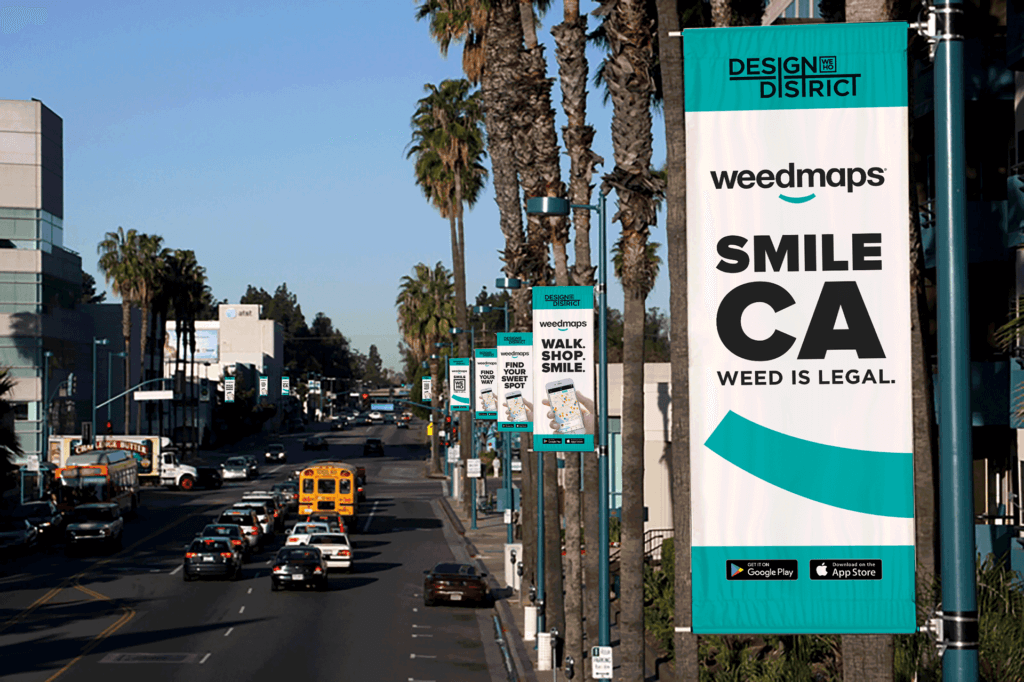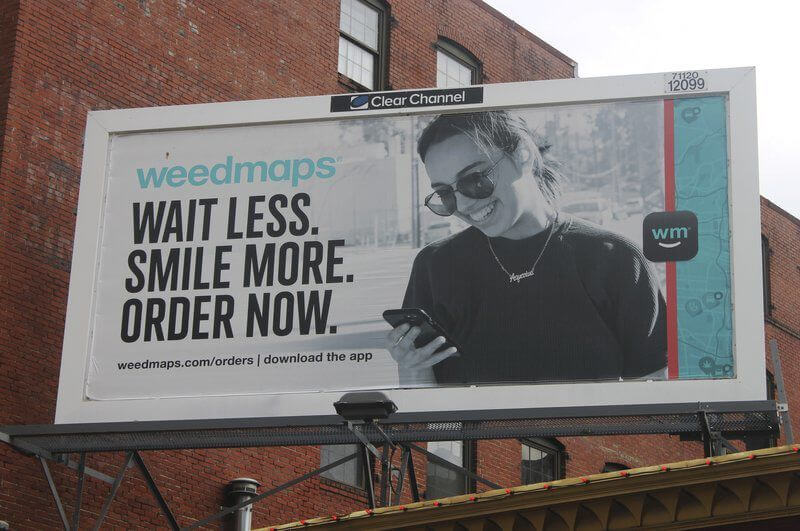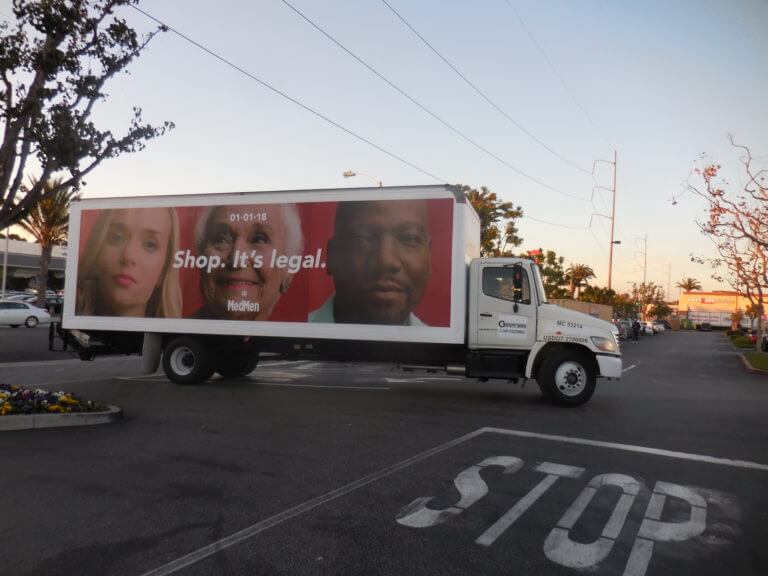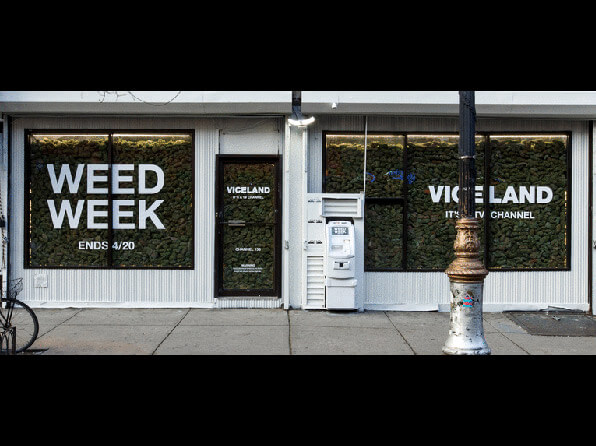
The advertisement of cannabis is regulated in a very strict and particular manner since its legalization in Canada and some U.S. states. In Canada, there are unforgiving rules and regulations around the advertisement of cannabis not just because it has only recently become a legally used substance, but also because it’s government-regulated like the sale of alcohol. There is a long list of prohibited promotional tactics created by The Cannabis Act including things like making it seem appealing to young people or evoking positive and or negative emotions towards it. The list goes on, providing little to no leeway when it comes to expressing creativity and enthusiasm in advertising for cannabis. In the U.S. on the other hand, the rules are a little more laid back when it comes to advertising cannabis. However, not all of the states in the U.S. have actually legalized the drug, so advertising is again limited. On the bright side, the very recent election brought on a new wave of cannabis legalization in five states including: Arizona, Montana, Mississippi, New Jersey, and South Dakota. Now there are 33 states in favor of legalizing cannabis in some form or another, demonstrating across the continent that attitudes towards the drug are becoming more progressive. The advertising industry is keen on taking advantage of the new legalization, however the barriers to entry are still quite significant. A lot of advertising channels are still hesitant on accepting cannabis ads, particularly online mediums. This is where Out-of-Home (OOH) advertising has been able to step in and fill in the gap that other advertising mediums have been tentative to.
The cannabis advertising market as it stands

The cannabis advertising market is something that’s extremely new to many American states. When the legalization of cannabis began in the U.S., there weren’t many precedents set in place for advertisers so when they decided to advertise for a cannabis company, they were kind of taking a shot in the dark. Now that there are more guidelines and established rules to follow, it’s becoming increasingly easier and less troublesome to advertise cannabis products. And it’s a good thing too, because the industry is booming! According to Forbes, the market for legal sales will hit $25 billion by 2025, with an annual growth rate of 14%.
Advantages of OOH
OOH is willing, able, and available
The OOH advertising medium has been fortunate enough to attain a very large percentage of the cannabis advertising share. According to Cannabis Business Times, nearly half of all ad spend to promote cannabis businesses went to the OOH advertising sector in the first four months of 2020. And OOH is happy to oblige.
When starting a business – OOH just makes sense
It isn’t fair to say that OOH gets to enjoy such a large share of the cannabis market just because it’s one of the only mediums available. OOH will remain a vital part of cannabis advertising even when other mediums come around to advertising it. Generating high awareness and engagement about a new company is imperative and will more than likely determine the success of the company. This is true for cannabis brands who need to target specific store locations, dispensaries, and local cannabis consumers. Now cannabis dispensaries are cropping up everywhere and the consumers that venture to them are more often than not from around the neighbourhood. Moreover, the advertisement of cannabis is still illegal at the federal level, which means that hyperlocal and hyper-focused advertising is the best option right now. Truck-side OOH advertising specifically has the ability to promote a new dispensary or new strain of cannabis hyper-locally, passing through neighbourhoods and local streets delivering the message to all those that would be interested in the ad.

OOH is also a great tool to use in a media mix when promoting a new cannabis store or dispensary. Mobile in particular works really well with OOH billboards now that geofencing areas are relatively easy and inexpensive to create. When consumers pass within the geofence threshold, they’ll get timely and relevant messaging related to the ad enticing them to visit the new store or check out new products online. It’s fairly critical for cannabis brands to establish themselves within their communities and mobile ads paired with OOH is very effective in garnering impressions.
Another aspect of cannabis advertising to consider when starting out, is making sure that the money that goes into the advertising is effective and worthwhile. Every company wants to make sure they’re getting a better bang for their buck and cannabis companies are no different – especially when your ad budget isn’t very big. Programmatic buying of OOH has solved this problem. Cannabis brands can now create programmatic ad campaigns that allow them to pay for delivered impressions only while targeting specific audience-segments and staying within the governing guidelines. To check out a more in-depth article about how programmatic is entering the OOH advertising market in a big way, check out this link.
OOH is trusted

Delivering a trusted message to a mass audience is essential for cannabis companies. This is because it’s such a new and unfamiliar territory for many people. Trying new products can already be a daunting task for a lot of people, add the fact that cannabis is recently legal in 33 states and is deemed unsuitable by many. All of these factors make it difficult for consumers to trust cannabis advertising. However, according to a MarketingSherpa survey, 69% of the 1,200 Americans surveyed saw OOH as a trustworthy advertising channel. OOH delivers a tangible, uncomplicated, and real message to consumers – one that they tend to trust. OOH advertising makes it much easier for cannabis companies to promote themselves without being misunderstood or misrepresented. Moreover, truck-side advertising companies like Movia create ads that feel like an extension of whatever brand they’re advertising for, not leaving any room for misconceptions or untrustworthiness.
Fantastic Examples
Now let’s take a look at some of the best and most creative examples of cannabis advertising using the OOH medium.

When cannabis became legal in California, the state’s largest retailer, MedMen, quickly took advantage of the ad space. They created the largest-ever promotional campaign for cannabis in history by placing billboards in iconic locations like LA and San Diego, then branching out by using truck-side advertising and bar media. The messaging is what makes MedMen stand out amongst other cannabis brands. They focus on the ordinary people that use cannabis, helping people identify with other customers that use their products. The most common tagline that they put on all their ads say, “Heal. Relax. Shop. It’s Legal”, adding a personal and encouraging touch. The truck-side ads made huge waves across California as people began to take pictures of the ads and post them on social media platforms. Integrating OOH with mobile and social marketing has worked wonders for MedMen and is a large part of why they’re such a successful brand.

A lot of cannabis companies are attempting to advertise the herb as a medical option. Dosist, one of the leading cannabis companies in the U.S., focuses on the therapy aspect of cannabis in their OOH advertisements. In one of their ad campaigns they have used billboards to illustrate the product, which looks like a medical device with sleek packaging; something you would get from a pharmacy. Dosist has put in quite the effort to destigmatize the use of cannabis for medical reasons with this campaign. The ads also emphasize, “Dose-controlled cannabis therapy”, which targets those who are curious about cannabis but might feel a little unsure when it comes to what they should be buying and how to regulate their use of it. This campaign worked wonders for Dosist because the aesthetic of the billboards, coupled with the messaging helped to engage with people that don’t usually buy cannabis.
Eaze, a cannabis delivery service based in San Francisco, recently created a humorous and creative OOH and digital ad campaign that embraces the “high” life. Eaze decided to celebrate stereotypical cannabis habits with themes like space, food, and relaxation. They created billboards that included the tagline, “Highly Calculated Delivery,” emphasizing their tech-driven platform and the newly accepted cannabis culture. All of the billboards include vibrant colours and cool imagery, and some are even hyper-locally targeted. One Eaze billboard in San Francisco says, “There are 50 trillion gallons of water in the SF Bay. That’s a lot of bong refills”. Eaze is definitely targeting the younger generations, who are legally allowed to buy cannabis, with their references and creative and it’s working!

Muncheez, a mobile app that allows users to find cannabis delivery in their area, created a mobile ad campaign to drive sales and recognition. The trucks targeted multiple parts of LA and were successful in gaining responses with their drive-throughs. The messages on the trucks were very simple but appealing, “find your feelgood”, and included a bunch of phones with locations to cannabis stores – giving passersby a first glance understanding of the app’s capabilities.

Viceland won the Platinum OBIE Award, the highest honor of the year for OOH advertising, with their Weed Week campaign. The television channel rolled out billboards, mobile ads, and a massive double-decker wrapped bus that all had weed pouring out of it. Viceland created Weed Week, celebrating all things to do with cannabis for a whole week. They created a series of humorous ads, one that rolled into Washington, DC inviting people to “smoke weed with Jeff Sessions”. Viceland took the “go big or go home” mentality to the next level and it was a huge success. People were taking photos of the ads and posting them all over social media, garnering a lot of hype for the television network.
What to take away from all this
The legalization of cannabis has got advertisers all over North America very excited. The cannabis industry is a multi-billion-dollar industry that has a lot of untapped potential in regard to its advertising. There are currently very few cannabis companies that run the entire industry, however as cannabis becomes a more locally sought-after product, the more community-based and smaller cannabis companies will crop up. And with these smaller companies, comes the need for hyper-local advertising. OOH has already proven to be an effective medium for the cannabis industry and will continue to be as the demand for quality, local, and accessible cannabis becomes more frequent.




